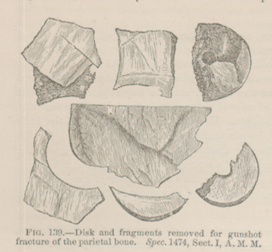Title: D——, John F.
Source text: Surgeon General Joseph K. Barnes, United States Army, The Medical and Surgical History of the War of the Rebellion. (1861–65.), Part 1, Volume 2 (Washington, D.C.: Government Printing Office, 1870), 277-278.
Civil War Washington ID: med.d1e16905
TEI/XML: med.d1e16905.xml
CASE.—Private John F. D——, Co. E, 178th New York Volunteers, aged 37 years, was accidentally wounded on July 12th, 1863, by a conoidal ball, which struck the parietal bone half an inch posteriorly to the coronal, and one inch to the left of the sagittal sutures, passing backward, and emerging about four inches from the point of entrance. He was admitted into Armory Square Hospital, Washington, the next day, in a somewhat stupid and restless condition, with anxious countenance. Partial paralysis of arm, and paralysis agitans of forearm of the opposite side existed. An examination of the wound revealed depression of a small portion of the external plate, one-half inch in length by one quarter of an inch in width. A fissure extended one inch and three-fourths posteriorly from the depressed portion of the bone. The fracture of both tables could be readily recognized by the pulsating motion of the fluid which had accumulated in the cavity. Surgeon D. W. Bliss, U. S. V., applied the trephine over the depressed portion. Great difficulty was experienced from the detached portions of the inner table moving under the trephine. These fragments were removed by means of forceps. The dura mater was abraded at several points, but not torn through. After the operation, the wound was carefully cleansed, water dressings were applied, the patient placed in a semi-recumbent position, and quiet enjoined. A gradual improvement took place, and by July 29th the case presented all indications of a speedy recovery. Paralysis steadily diminished. He was sent to the DeCamp Hospital, New York Harbor, October 29th, 1863, and transferred to the Veteran Reserve Corps, March 3d, 1865. The specimen is figured in the wood-cut, and shows a disk and five fragments of bone. One and a half square inches of the internal table were removed. The specimen and history were contributed by Surgeon D. W. Bliss, U. S. V.
